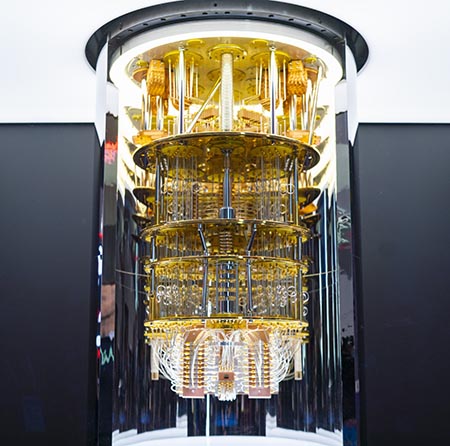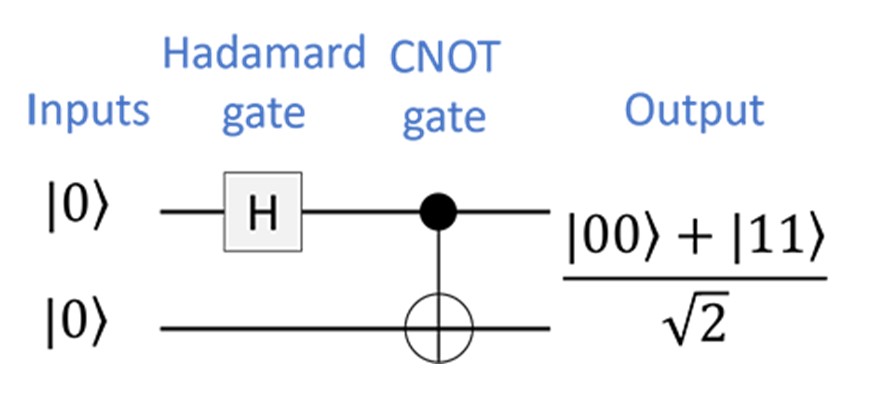Abstract—This research suggests that quantum computing brings together ideas from classical information theory, computer science, and quantum physics. This modern way of computing is based on the science of quantum mechanics and its unbelievable phenomena. It Theoretically has computing power that is many orders of magnitude greater than that of conventional computers.
Keywords—entanglement, a quantum bit (qubit), quantum logic gates, decoherence, superposition
I.Introduction
Quantum computing is one of the hottest topics in the technology sector today. The technology enables individuals and companies to solve computational problems previously considered intractable. Cryptography, chemistry, quantum simulation, optimization, machine learning, and numerous other fields have been significantly impacted by this technology. While quantum computers aren’t going to replace classical immediately, quantum technology is significantly changing the way the world operates. Quantum computing is generally viewed as a field of study centered on developing computer technology based on the principles of quantum theory. This area of physics explains how matter and energy behave at the atomic and subatomic levels.

1.1 Existing system
Classical computing is another name for binary computing. In this traditional approach to computing, information is stored in bits that are represented logically by either a 0 (off) or a 1 (on). Today's processors, including x86 and ARM Processor, support classical computing.
1.2Motivation
Quantum computers can solve what computer science calls "NP-complete" problems, the problems that are impossible or nearly impossible to calculate on a classical computer.
The trick in quantum computing is to harness the entanglement of different particles -- what Einstein called the "spooky action at a distance" -- that allows one particle to affect another somewhere else.
II.System Overview
The Quantum Computer is programmed by changing the magnetic conditions around quantum bits, or "qubits," creating relationships between them that model the physical embodiment of the equation the programmer is trying to solve. The results are read by detecting the direction of the current within the qubit when the calculations are complete.
Qubits are prone to errors. All sorts of environmental factors like thermal fluctuations, electromagnetic radiation, and magnetic fields can knock a qubit out of its intended state. That degradation of information is known as decoherence and can occur in a fraction of a second. Despite the use of refrigeration to reduce thermal fluctuations, decoherence eventually creeps in and produces hardware errors, like accidentally flipping a qubit’s state from 0 to 1.
1.1 Logic-level compilation
A quantum circuit is a map of sequential logic gates that are applied to a series of qubits to run an algorithm. A simple example of a circuit that two qubits in a Bell state are shown

Two qubits start in pure 0 states. A Hadamard gate acts on the first qubit and puts it in a superposition of states 0 and 1 with an equal probability of finding the qubit in each state. The two-qubit CNOT gate flips the target qubit (⊕) to 1 only if the control qubit (•) is in state 1, thereby producing the entangled output state shown.
1.2 Quantum algorithms and applications
Quantum algorithms play the same role as classical algorithms: They provide step-by-step instructions for completing a computational task.
Although a regular algorithm could in principle be run on a quantum computer, a true quantum algorithm takes advantage of the underlying hardware’s quantum nature. For example, manipulating one qubit in a quantum computer affects the entire n-qubit state and each of the 2n coefficients needed to describe it, effectively doing that many operations in parallel. However, it’s not quite parallel computing. When the final qubit states are measured, each is either a 0 or a 1; the algorithm outputs only n values rather than all 2n coefficients.
Quantum Fourier transforms are also significantly faster than their classical counterparts. Other tasks, such as playing chess, garner little to no benefit from quantum algorithms because the number of steps needed would still grow too quickly with the complexity of the problem.
A variational quantum algorithm is a compromise between classical and quantum ones. It breaks up a computation into a small quantum component and a larger classical optimization problem and therefore requires a much smaller quantum computer than, say, the quantum Fourier transform. Such algorithms are promising for solving problems in finance, logistics, and chemistry.
III. User Interface, QAAS, and Operating System
Most people who want to use quantum computers aren’t going to build or even buy one—at least not anytime soon. To facilitate access to the limited existing quantum computing resources, companies have put together cloud-based infrastructures that allow remote operation. As in a classical computer, the highest level of the quantum computing stack provides the interface that users interact with.
Amazon Braket, Microsoft Azure Quantum, and Rigetti Quantum Cloud Services are examples of quantum-as-a-service (QAAS) offerings. However, those companies aren’t necessarily providing access to their own quantum computers; rather, they connect users and computers. For example, Amazon Braket can connect users to resources from D-Wave, Rigetti, and IonQ. That approach makes quantum computers similar to other managed, cloud-based computational resources, such as graphical processing units.
The above services can be used to write code using high-level programming languages. The resulting algorithms probably wouldn’t look particularly exotic to someone with programming experience. For example, the open-source software development kits Ocean (from D-Wave), Qiskit (from IBM), and Forest (from Rigetti) support the programming language Python. Languages specifically designed for quantum computing include Quantum Computation Language (QCL), which resembles C, and Q Language, which works as an extension of C++. The code defines a sequence of operations that constitute a logical algorithm.

A short Qiskit algorithm, akin to a “Hello, World!” program, initializes one qubit in state 1.
IV. Acknowledgement
We sincerely thank the faculty of the Electronics and Communication Engineering Dept. at Anil Neerukonda Institute of Technology and Sciences for giving me the chance to write this paper. Without their active involvement and the right guidance, this would not have been possible.
V. References
- https://science.jrank.org/computer-science/Quantum_Computers.html
- https://www.sri.com/story/a-brief-introduction-to-quantum-computing/#:~:text=Quantum%20computing%20is%20generally%20viewed,the%20atomic%20and%20subatomic%20level
- https://blog.wordvice.com/formatting-research-paper-headings-and-subheadings/
- https://www.techtarget.com/whatis/definition/classical-computing#:~:text=Classical%20computing%20is%20another%20name,ARM%20processors%2C%20support%20classical%20computing
- https://www.wired.com/2007/02/the-father-of-quantum-computing/#:~:text=Deutsch%20invented%20the%20idea%20of,possible%20forms%2C%20across%20multiple%20universes.
- https://physicstoday.scitation.org/do/10.1063/pt.6.1.20210305a/full/#fifth_sec
Shankar Nambala
Dept. of Electronics and Communication Engineering
Anil Neerukonda Institute of Technology & Sciences
Visakhapatnam, India
nssaiumashankar.20.ece@anits.edu.in
Note: Opinions expressed by authors are their own.

Padala Satyanarayana (SN Sir)
View Details
You may also like

JEE Mains
Joint entrance exam popularly known as JEE Mains is conducted by the National Testing Agency (NTA). It is the gateway for admission to all NITs, IIITs, CFTIs (Centrally Funded Technical Institutions) and

EcoQuake
EcoQuake: Sparks in the Silent Street!! a Sci-Fi movie idea to Christopher Nolan!!Dear Friends and StudentsWe all think Electric Vehicles are Green! Over 26 million electric cars were on the road

Need for Electrical Vehicles
What is an EV?Electrical vehicle is a vehicle where one or more electrical motors are used for propulsion. These motors will be powered by batteries (for electric cars, two wheelers, etc.) or collector

How we won Smart India Hackthon?
SMART INDIA HACKATHONSmart India Hackathon is a National wide platform initiated to enhance and utilize the innovation and creativity of students which helps the nation.In this many organizations

A demonstration of Influencing people without a formal Authority through CORE values
Recently, I read a book "Project Management for the Unofficial Project Manager" by Suzette Blakemore, Kory Kogon, James Wood. It stresses on the mastery of four foundational behaviours to be

Top 7 Countries to Study Abroad for 2023: Uncover Exciting Opportunities
Planning to study abroad? How exciting! Before you dive into this incredible experience, it's important to find out which countries offer the best education in every possible way. But hold

The Thirsty ChatGPT!
The Thirsty ChatGPT! Cultivate Responsible Prompt Engineering! Be Accountable for your Prompts and behind Water footprint!Dear Friends and Students,During a recent visit to a friend's home,

Let Them Pop: Why Students Need Their Own Time to Excel
Dear Teachers and Parents,As parents and teachers, we often expect all students to excel at the same rate, assuming that if they are all exposed to the same environment and resources, they should all

What is that ONE JOB LEFT?
Many Jobs are on Verge of Closure Except this One! Raise or get Rinsed! What is that ONE JOB LEFT? Read this Perspective!Dear Friends and StudentsNov 2015, theguardian.com published an article

Failure Conference!! Sounds Interesting!! You Heard Right!! Read This!
Failure Conference!! Sounds Interesting!! You Heard Right!! Read This!Dear Friends,Occasionally, we hear about Success Meets! Whether it’s an organization or an individual, success is generally
















